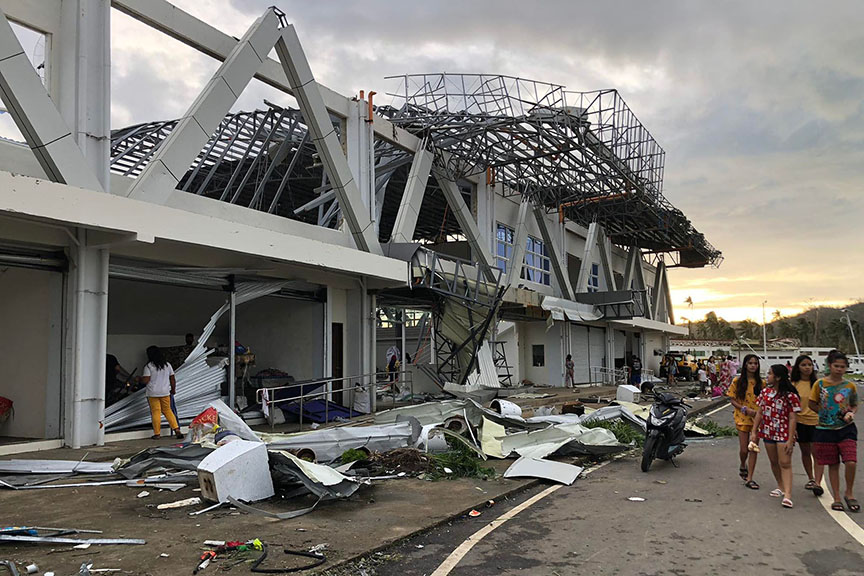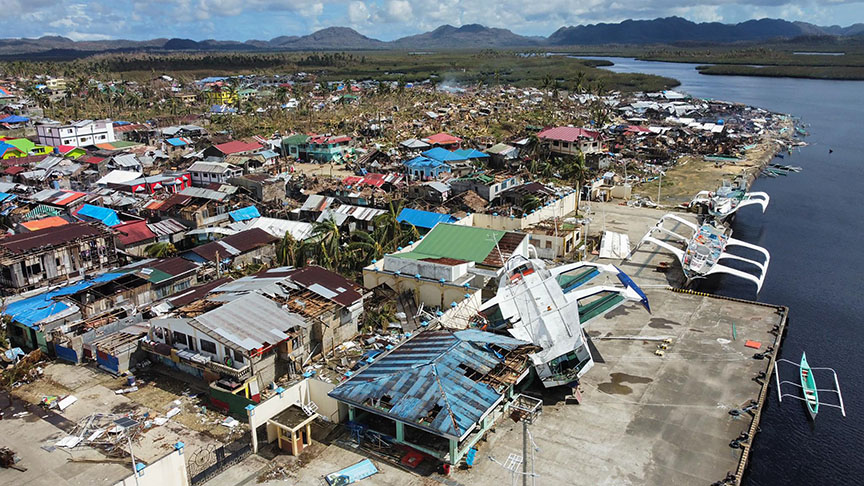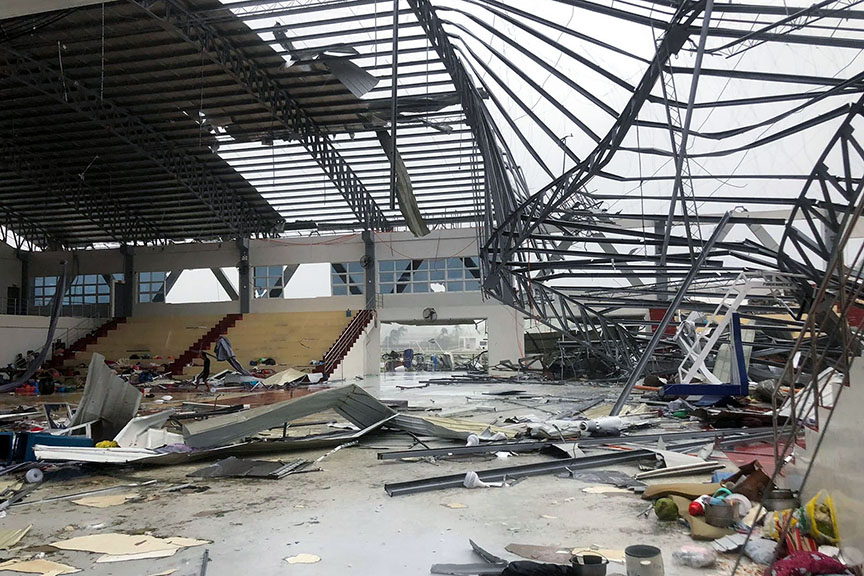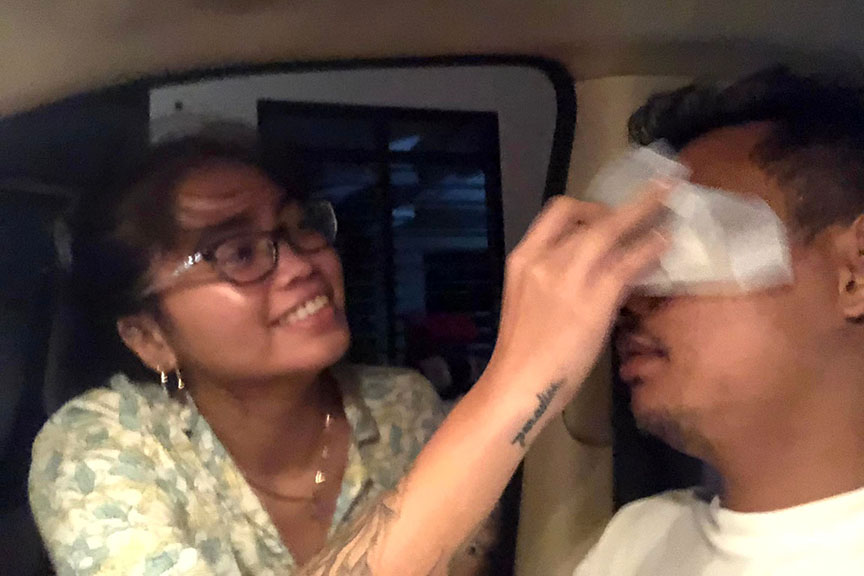2nd of a series [Read the first part]
DAPA, Siargao Island (MindaNews / 09 January) – As we raised our arms in victory amid the destruction around us at the Siargao Sports Complex caused by the Category 5 Typhoon “Odette” on December 16, I gathered my friends to initiate a survival plan.
 The gym at the Siargao Sports Complex collapsed as Typhoon “Odette” battered the island. MindaNews photo by ROEL N. CATOTO
The gym at the Siargao Sports Complex collapsed as Typhoon “Odette” battered the island. MindaNews photo by ROEL N. CATOTO
“What happened to your left eyebrow?” asked Matt Cuadra, a colleague of mine in our advocacy to help local farmers in Siargao Island.
“It doesn’t matter now, I will tell you the whole story later,” I told him. As I wiped the blood using wet wipes, I said: “Layo ra ni sa atay, di pa makapatay (This is far from the liver, this won’t kill me).”
“There’s a possibility that winds may blow harder. Older people refer to this as ‘ikog sa bagyo’ (tail of the storm), which is as deadly. This means we should be very careful. All those debris still hanging above may fall on us,” I said loud and clear.
“Let’s do this very quickly but safely. Protect yourselves at all times,” I stressed.
It was past 3:30 in the afternoon, two hours after “Odette” made its first landfall in the Philippines, right on Siargao Island. The wind was still howling although not as fiercely.
We had to go over our second evacuation plan. Second because our first evacuation site was severely damaged by heavy metal trusses that collapsed on the ground.
Water, food, shelter
Listen, Matt: “For our survival in the next few days, it boils down to three things: water, food and shelter. Do you hear me? Again. Water, food and shelter.” I reiterated as I urged him to get out of the badly damaged building.
“I will head to the Sports Academy Center. Follow me there along with your kids. I’ll secure our spot and you can follow me there,” I said, pointing to the building that appeared to have no damage.
I had done a reconnaissance around the complex before the storm so I was confident of what I was doing. “See, what we did, we managed to save lives, Matt! Congrats to all of us!” I told him.
As we parted to execute our plan, I reminded him to watch out for flying roofs or falling debris and sharp objects.
He nodded without hesitation even as visibly, he was still shaken and horrified.
As I trudged to leave the ill-fated gymnasium of the Siargao Sports Complex where we sought shelter from the fury of “Odette,” I couldn’t believe that the place where I used to play basketball almost thrice a week is a complete mess.
I was right in choosing this place as my evacuation plan, after thoroughly studying the 3D map of the National Operational Assessment of Hazards (NOAH) project. But I didn’t expect that the multi-purpose gymnasium built at a cost of hundreds of millions of pesos, and inaugurated only a month before “Odette,” could not withstand the fierce force of the typhoon’s wind. Up to now I still wonder why the small resorts in the island survived the onslaught of 2021’s strongest typhoon.
 The wrath of “Odette.” Photo courtesy of Janos Andanar of Surigao Photo Club
The wrath of “Odette.” Photo courtesy of Janos Andanar of Surigao Photo Club
Outside the gym, I saw vehicles turned upside down. A refrigerated truck smashed up on the concrete wall and tipped over. Tricycles flew to different directions. Cars with broken glasses and dents.
To my surprise, the van of Payag Suites, where I stayed before moving to the sports complex, was intact although the glass on the back was shattered, the side mirror on the left gone. Beside it, a Multicab turned upside down and a sedan was smashed.
Lawyer John Cubillan, my business partner who owns Payag Suites, would be glad to know that the van incurred only minor damage.
I noticed that the other cars we brought to the sports complex and parked beside the grandstand three days before the typhoon were all unscathed.
The wind continued lashing out as I moved towards the Sports Academy, my two arms on defensive guard on my head, like a boxer expecting a pummeling barrage.
I reached the building, nearly falling on the moss-covered floor.
This building served as a quarantine facility for COVID-19 patients when cases in the island surged around May to September. There were two buildings facing each other.
I went to the building on the left and found the first room locked. I tried several times to open it but failed.
In desperation, thoughts came rushing in. What kind of evacuation site is this? All doors locked? It’s for VIPs? My temper flared up.
I was looking for a hard object I could use to smash the door handle with. I went to another room. As I opened it up, whoa, there were four people inside.
“How are you guys? I asked. They looked at me and could not respond immediately. They looked terrified. And so I told them: “Yes! We survived!” “Yes!” they said in unison, now smiling. I said, “Congratulations!”
“Hamok patay sa suyod sa gym, bai (Did someone die in the gym?)” a younger guy among the four asked. “No one,” I replied.
“Imposible! Ako mga lumon sanan mga igsuon jadto man god sa sayod (Impossible! My relatives and siblings are inside the gym)!”
“Wayay patay lagi. Di man kaw motoo dajon (No one died. Why you don’t believe me),” I said, and told him to go out and see for himself.
“I was the last man in the basketball court area before its trusses collapsed,” I said.
The four guys dropped their stuff and happily dashed to the ruined sports arena to join their relatives.
Shelter secured
Now that the room is empty, maybe we can use this in the meantime. (The four later settled in the next room with their relatives.)
But the room is flooded, the rain apparently seeped through the windows with the strong winds of “Odette.”
I took a sheet of broken plywood to drive the water out of the room, soaking my shoes and socks in the process.
I checked where’s the closest toilet was. Checked the faucets, but there was no water.
I spotted a mop with handle close to the bathroom. I took it, soaked it in soap and chlorine, and started cleaning the floor.
Fifteen minutes later, people began arriving in the building.
“Ops, find your spots! There are lots of rooms in this building. Check them out,” I said. I noticed that the other rooms were COVID-19 facilities, with plastic sheets still hanging to serve as dividers.
A couple friends of mine, Alexa and Drew Paroz, came with their stuff and a dog. Alexa helped me clean the room as lots of people were coming in.
Many more familiar faces arrived. I welcomed them with a smile, and offered the room. “Come inside, this is our shelter. I’ve cleaned it already. Please leave your slippers or shoes outside,” I said.
Matt came an hour later, not following my instruction to come as quickly as possible.
“Where have you been?” I asked. “I was worried about you.”
“I got everything, including your stuff,” Matt replied. “And I got loads of goodies, too,” he said with a smile on his face.
A stockpile of relief goods
“Those rooms with rollup doors ravaged by the typhoon,” he added, “contained a stockpile of relief goods. They’re now exposed to the rain and some rice got soaked in water.”
He smiled even wider when he said that the evacuees looted the rooms. Well, apparently that included him.
Okay, at least now we have food. Problem No. 1 solved.
As I was outside the sports complex, I had hesitation to carry out the plan as the wind was still revving up.
 The gym after “Odette,” MindaNews photo by ROEL N. CATOTO
The gym after “Odette,” MindaNews photo by ROEL N. CATOTO
As I stood there, I noticed a fallen sheet of metal roof already lying on the ground got blown by the wind. It would hit me for sure, so I ran in my attempt to avoid it. But it hit me still on the right side of the body. Miraculously, I wasn’t injured. Everyone around asked if I was hurt, so I said “No.” They joked I was like Superman.
Before the typhoon’s landfall, a veteran war and disaster journalist colleague of mine, Froilan Gallardo, texted me not to get out of the gym until the typhoon is over, for safety’s sake. He would be mocking me now had he been around.
I told the men in our group to join me grab some rubber mats so we could cover the floor.
When we got back, the room was already filled with more than 50 people, jampacked like sardines.
After an hour, people came in, carrying sacks of rice and boxes of assorted canned goods. Uh-oh! There must be looting across the complex, I thought.
So I asked: “Where did you get that?”
Like my colleague Matt, they were smiling when they replied: those padlocked rooms at the gym with rollup doors were damaged by the typhoon, and partly exposed what was inside. The hungry mob forcibly opened them, and everyone joined the fray and took the goodies.
Bingo!
The canned goods, lots of them, to my surprise, were all of the Bingo brand. Can you guess the nickname of our congressman, Rep. Francisco Jose F. Matugas II of the first district of Surigao del Norte? Tadaaaa! But I doubt if he owns that canning company. I learned he bought all those canned goods for “ayuda” (relief goods) during the COVID-19 lockdowns.
I felt weary, thirsty and tired. I set up my portable stove and boiled water for coffee. While waiting for it to boil, I was curious to look at the closed room beside ours.
Some young men offered to help me open it up. One of them grabbed a flashlight and barged into the room. “Ohoy! Grasya!” one yelled.
There must be a treasure trove hidden in this room. I was so curious. I fired up my flashlight, whoa! Full of boxes of goods. But I told them to close the room. Enough looting already.
“Ayaw ninyo hilabte na” (Don’t take anything there).” I said.
The young men nodded and closed the room. I was told some folks believe I’m a cop. Standing 5’9” tall with cropped hair, maybe I look like one. Must be why they follow my orders.
Finally, I had my cup of coffee, and shared some to friends.
Then I started to cook rice as some girls helped me out cleaning the kitchenware we brought along.
While waiting for the rice to cook, which would take an hour for the small portable burner, I made the rounds to every group of evacuees to tell them what we should do in the morning.
Crisis management
“Let’s organize ourselves. We have to establish crisis management here for us to survive,” I said.
These are the four things that needed to be done the next day:
- Search and rescue
- Search for available water sources
- Restoration of power generator
- Set up a crisis management center
Took me 10 minutes to talk to each group.
“You were eating rice, some were eating looted canned goods, some ate corned beef. Some were able to eat but never able to drink water. This happened because we are not organized,” I told them.
After convincing the five groups what we needed to do, I felt tired.
I went back to my place just in time the rice was cooked.
We had our dinner, some evacuees joining us, consuming the rice shared by fellow evacuees-turned-looters. I slurped the leftover tinola I cooked in the morning. I couldn’t believe Matt saved it.
I made the rounds again after dinner, discussing the plans for swift execution by morning.
“At 5 a.m. tomorrow let’s go out and let’s regroup here at 5 p.m. Let’s see what we can find.”
I felt so low and tired, but I had to talk to all the groups before going to my room.
I chanced to see a friend, Rengie “Gboy” Cabanday of Corner Cafe, who looked terrified. He came all the way from his ravaged town of General Luna to the sports complex. He arrived past 9:30 in the evening.
“How are you? Where were you when the typhoon hit?” I asked.
Houses flattened
“I was in GL and sought refuge at Purok 2 at the solid structure close to the Catholic Church. Houses along the shore to Poblacion 2 were flattened,” he said.
I was speechless for a few seconds. “All people there were killed?” I asked.
 Damaged houses near the coast. MindaNews photo by ROEL CATOTO
Damaged houses near the coast. MindaNews photo by ROEL CATOTO
He couldn’t answer me because he fled the town right after the wind began slowing down. He rushed coming here to reunite with his family, who evacuated here in the sports complex.
I came back to the our room, which was packed with people as tight as sardines in a can. Over 50 people, all tired, thirsty and hungry.
All utensils and kitchenware were still unwashed. I grabbed soap and washed them all.
“You don’t need to wash it now. You should rest,” Matt said.
“We will get sick if we don’t clean all these, then eventually we’ll die,” I said. “No hospitals are functioning with the extent of this damage,” I added.
One lass kept talking to me, asking me things but I excused myself as I need some things to do. “Sorry, I need to take a bath and brush my teeth,” I told her.
No more space
Now feeling fresh, I wanted to hit the hay, but I couldn’t find any space for myself inside the room that I claimed. Women and children, including a few dogs and cats, lay on the rubber mats.
I asked Matt to sleep in the van instead. Three of us stayed in the van, with Matt and his son Memoy.
As we rested, I asked Matt: “What if COVID is here? We’d all be dead noh?”
Silence from him, so I answered myself: “Maybe we’d live. But we’d still die if nobody can come to help us.”
We were listening to Matt’s worship music at the Starex van. He was playing “Eye of the Storm” by Ryan Stevenson. I listened to the music intently. With the situation we’re in now, tears flowed down my cheeks.
Matt went to sleep with his son. But I couldn’t. It’s now past 10:30 p.m.
So I grabbed my flashlight, bolo and a water bottle and stuffed them in my bag. I walked outside the sports complex to look for water. My best hope would be the water sources of yore, maybe spring water.
Alphonse Valenzuela joined me in the walk as I planned to check out the remote areas of Barangay Osmeña, where the Sports Complex is situated, in the hope of finding water.
But just getting out the sports complex was already a struggle with the fallen trees and electric poles, along with tons of other debris blocking the road.
I decided to visit first my former restaurant worker, Yulie Razon, who is more familiar with the place. She was former assistant manager of Chef Justice, our restaurant in General Luna.
Her family’s house was completely ripped apart, but Ate Yulie and her husband were smiling. Smiling because they are still alive and kicking. Not six feet under.
No water
When I asked if she happens to know of spring water sources around here, she said there’s none. My shoulders dropped at the news.
I asked her son to join me to the sports complex so he can get some of my relief goods.
Back in the complex, I noticed people bringing water melons, squash and other goods.
When I asked, they told me they got it from the mini market beside the Sports Complex that were completely destroyed. Goods were scattered along the road.
 Author gets treated by Alexa. MindaNews photo by ROEL N. CATOTO
Author gets treated by Alexa. MindaNews photo by ROEL N. CATOTO
My friend, Alexa Ray Paroz, treated my wound on my life eyebrow. I couldn’t thank her enough.
Back in the van, I rested. But my mind keeps bothering me with thoughts of various concerns.
If the newly built sports complex, supposedly the strongest infrastructure in the island, collapsed, how much more those makeshift houses near the shorelines of General Luna? My neighbors along the beach, my hard-headed friends who refused the call for preemptive evacuation? What could have happened to them?
What about my family and friends in Surigao City? My relatives who live close to the beach? They’re so near, just a short boat ride away, but I have no way of knowing, with electricity and phone signal dead.
I checked the time. It’s past 2 a.m. I can’t sleep this way. I can’t sleep in this unfamiliar place.
Thoughts got deeper until … apparently I fell asleep. (Roel N. Catoto / MindaNews)
To be continued. Next: Search for water, rapid rescue launched
